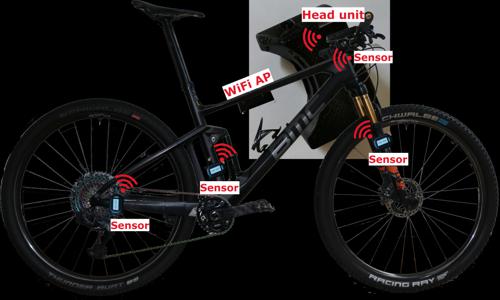BikeAreaNetwork - Measuring and analysing vibrations in mountain bikes
- Degree programme: BSc in Elektrotechnik und Informationstechnologie
- Author: Adrian Jäggi
- Thesis advisor: Prof. Dr. Andrea Ridolfi
- Expert: Nina Zenger
- Year: 2021
Vibrations hinder athletes on mountain bikes in performing at their highest level. To reduce these vibrations, there are several bike setup options. With the BikeAreaNetwork, it is possible to measure, display and store vibration data and suspension performance in real time. This helps with finding and verifying the best suspension setup on any track.
Motivation
Science shows that vibration in certain frequency ranges hinder athletes to reach their highest level. This project aims to quantify the vibration occurring at different places of the bike. The BikeAreaNetwork helps riders and mechanics to easily find the best suspension setup and the optimal tire pressure.
Solution
The BikeAreaNetwork we have developed is composed of a sensor network (vibration measurement) and a processing algorithm (vibration analysis). The sensors are connected wirelessly via a bridge (Raspberry Pi Zero W) to a head unit. The head unit is a bike computer implementing the processing algorithm. The system can be mounted on any mountain bike and its wireless setup makes its installation very simple.
The processing algorithm quantifies the vibrations using metrics based on scientific literature. The most important metric is the root-mean-quad (RMQ). Other metrics are real time graphs of the vertical acceleration at each sensor, a Fast Fourier Transform (FFT) of this vertical acceleration as well as a suspension performance plot. The suspension performance is being calculated by dividing the unsuspended acceleration by the suspended acceleration. The factor shows how much the suspension attenuates the vibration.
The head unit also stores all the calculated values to local log files. These log files may be used for further analysis after the testing.
Results
The BikeAreaNetwork efficiently measures the vibration data, processes it, and enables the display of the relevant computed metrics on the bike computer (graphs, values). In addition, the metrics are logged for further analysis in the bike computer.
Outlook
Future improvements include:
- The optimisation of the processing and display code, in order to increase the display speed and reduce the energy consumption by reducing the computational burden;
- The use of the computed metrics to actively regulate the lockout of the suspensions. An open suspension attenuates vibration, but diminishes the power transfer into forward movement. Therefore, an automatic lockout will improve the rider's performance by switching into the optimal lockout mode autonomously. This requires real time vibration data, which the BikeAreaNetwork is indeed able to provide.

